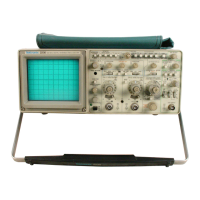Theory of Operation—2230 Service
oscillator that operates at a frequency set by R919 and
C919 (approximately 60 kHz). A sawtooth voltage pro
duced at pin 5 of U930 is compared internally with the out
put voltage produced by the two internal error amplifiers.
Whenever the sawtooth voltage is greater than the error
amplifier output voltage, Q9070 is biased on to supply
current to the remaining portions of the switching circuitry
and charge C940. The two error amplifiers maintain a con
stant output voltage and monitor the output current of the
Preregulator. One input of each amplifier is connected
through a divider network to the 1C internal +5 V refer
ence. The output voltage of the Preregulator is monitored
by the voltage divider at pin 2. The voltage drop across
R907, produced by the Preregulator output current, is
applied to the internal current-limit amplifier at pin 16.
When the instrument is first turned on, the current-limit
amplifier controls the conduction time of Q9070. While
Q9070 is conducting, the output current increases until a
voltage large enough to permit the current-limit circuitry to
function is developed across R907. The current-limit
amplifier then holds the output current below the limiting
threshold of approximately 1 A. When the voltage across
C940 reaches approximately 43 V, the internal voltage
amplifier starts controlling the duty cycle of Q9070, and
the Preregulator will not limit current unless there is exces
sive current demand.
With Q9070 off, C907 charges to the output voltage of
the Power Input circuit. When Q9070 turns on, current
through the FET comes from the winding connected to
pins 1 and 2 of T906 and from C907. Current to C907 is
supplied by the winding connected to pins 4 and 5 of
T906. When U930 shuts off Q9070, the collapsing mag
netic field raises the voltage at the anode of CR907. This
diode then becomes forward biased and passes the
currents supplied by C907 and the winding connected to
pins 4 and 5 of T906. For this part of the cycle, current to
C907 is supplied by the winding connected to pins 1 and 2
of T906. This process continues for each period of the
oscillator, and the duty cycle controlling the conduction
period of Q9070 is altered as necessary to maintain 43 V
across C940. During each oscillator period, Q908 is used
to discharge the gate-drain capacitance of Q9070. At the
shutoff point, Pin 10 of U930 goes LO to reverse bias
CR908 and turn on Q908 to switch off the FET.
Once the supply is running, power to U930 is supplied
from the winding connected to pins 6 and 7 of T906. Diode
CR920 half-wave rectifies the voltage across pins 6 and 7
to keep filter capacitor C925 charged and to maintain sup
ply voltage to U930 through Q930.
Instrument protection from excessive output voltage is
supplied by silicon-controlled rectifier Q935. Should the
Preregulator output voltage exceed 51 V, zener diode
VR935 conducts, causing Q935 to also conduct. The
Preregulator output current is then shunted through Q935,
and the output voltage quickly drops to zero. With the
supply voltage of U930 no longer being provided by the
winding connected to pins 6 and 7 of T906, the Preregula
tor shuts down, and Q935 becomes reset. The supply then
attempts to power up, but it will shut down again if the
overvoltage condition reoccurs. This sequence continues
until the overvoltage condition is corrected. A thermal
shutdown circuit is included to protect the instrument from
damage in case of fan failure or air flow restriction at high
ambient temperatures. Overheating causes the resistance
of RT950 to increase, eventually firing SCR Q950, which
reduces voltage on VR943. This causes all outputs to drop
to very low values, thus reducing total power dissipation.
To reset the circuit, the power must be shut off
momentarily.
Inverter
The Inverter circuit changes the dc voltage from the
Preregulator to ac for use by the supplies that are con
nected to the secondaries of T948.
The output of the Preregulator circuit is applied to the
center tap of T948. Power-switching transistors Q946 and
Q947 alternate conducting current from the Preregulator
output through the primary windings of T948. The transis
tor switching action is controlled by T944, a saturating
base-drive transformer.
When the instrument is first turned on, one or the other
of the switching transistors starts to conduct. As the col
lector voltage of the conducting transistor drops toward
the common voltage level, a positive voltage is induced
from T944 to the base of the conducting transistor that
reinforces conduction. Eventually T944 saturates; and, as
the voltage across T944 (and T948) begins to reverse, the
conducting transistor is cut off by the drop in base drive.
The other transistor does not start conduction until the
voltage on the leads of T944 reverse enough to bias it on.
The saturation time of T944 plus the transistor-switching
time determine the frequency of Inverter operation (typi
cally about 20 kHz). After the initial Inverter start up, the
switching transistors do not saturate; they remain in the
active region during switching.
Diodes CR946 and CR947 serve as a negative-peak
detector to generate a voltage for controlling the output of
the error amplifier. Capacitor C943 charges to a voltage
equal to the negative peak voltage at the collectors of
Q946 and Q947, referenced to the Preregulator input volt
age. This voltage level is applied to the divider formed by
R937, R938, and R939. The error amplifier, formed by
Q938 and Q939, is a differential amplifier that compares
the reference voltage of VR943 with the wiper voltage of
potentiometer R938. The current through Q939 sets the
3-48

